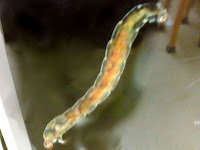









Today I started some more observations on my aquarium, I also worked on identifying some of the microorganisms in my aquarium using Free Living Freshwater Protozoa: a Colour Guide by D.J. Patterson and Pennak's Freshwater Invertebrates of the United States by Douglas Grant Smith. I made this video with the help of Dr. Kenneth McFarland that features some of the organisms in my aquarium, I request that it be watched before you proceed so you will have an idea what I am talking about. First thing that really caught my eye was a midge emerged from my aquarium (picture shown top right courtesy of maineflyfish.com/ hatches/midges/001.htm) and the midge larvae taken by me on my phone right below it. This was probably the one I observed last week and the smaller one is now moving around as a larger larvae shown in the video. There were also several rotifers (shown top left courtesy of water.me.vccs.edu/ courses/ENV108/lesson7b.htm) several are shown in the video. They are usually free floating in the water or eating scum off of plants. They typically have one-two tails. I have a few sketches in my notes, please refer to those to see a couple of other types. Another organism is shown in the video before the amoeba, it is unknown at this moment as to what it is, it appears similar to a colpidium, but has a large vacuole and a beak like "face." There are very small organisms that can be seen through the 10 objective and larger magnifications only called Halteria (shown bottom left courtesy of www.pirx.com/droplet/ list_img.html). These guys were small and made quick jerking movements, they fed on mostly dead matter, such as an insect carcass that I saw. There was also a copepod (aka cyclops) which was a small squid-like microorganism that is rather tricky to find (picture shown 3rd down on right courtesy of www.hudsonregional.org/ mosquito/program.htm). I have also seen what may possibly be water bears last week, but I have not seen them since. They were tricky to find the first time, they practically blend in with the water and move INCREDIBLY fast to catch in a microscope. There were several algae types Spirogirum (shown left courtesy of biology.unm.edu/.../ Non-floweringPlants.htm) and a another cigar shaped algae (diatom) shown bottom right (courtesy of steel.ced.berkeley.edu/.../ ?page_id=78). I also added a food pellet at the end of the lab session, I will let you know what happens with that next week. My notes are posted as well.
There is a typo at the end of the video, I accidently called Dr. McFarland Dr. Gellert, sorry.



